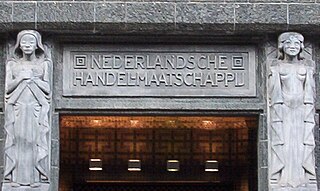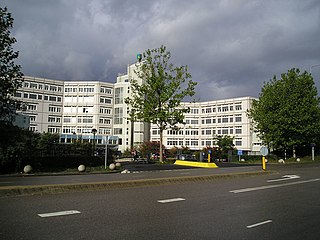
The Amsterdamsche Bank was a significant bank in the Netherlands, founded in 1871. [1] In 1964, it merged with Rotterdamsche Bank to form AMRO Bank (for AMsterdamsche & ROtterdamsche). [2]

The Amsterdamsche Bank was a significant bank in the Netherlands, founded in 1871. [1] In 1964, it merged with Rotterdamsche Bank to form AMRO Bank (for AMsterdamsche & ROtterdamsche). [2]
Amsterdamsche Bank was established on 5 December 1871 by a group of mainly German investors led by the Bank für Handel und Industrie (Darmstadt), in the context of German financial expansion following its victory of the Franco-Prussian War. It expanded rapidly from its base in Amsterdam to other cities in the Netherlands. In 1948 it took over Incasso Bank (est. 1891), [3] which it fully absorbed in 1956. [1]
Its elegant art nouveau head office building on Herengracht 597–601, designed by Eduard Cuypers and completed in 1897, was demolished in 1966. A subsequent head office building on Rembrandtplein, designed by Bert Johan Ouëndag and completed in 1932, is a notable art deco landmark of Amsterdam. [4]

ABN AMRO Bank N.V. is the third-largest Dutch bank, with headquarters in Amsterdam. It was initially formed in 1991 by merger of the two prior Dutch banks that form its name, Algemene Bank Nederland (ABN) and Amsterdamsche en Rotterdamsche Bank.

Hollandsche Bank-Unie (HBU) was a second-tier domestic bank in the Netherlands that Deutsche Bank absorbed in 2010. It had a notable international history.

The Nederlandsch-Indische Handelsbank was a Dutch bank established in 1863 to finance trade between the Netherlands and the Dutch East Indies. During most of the colonial period, it was the second-largest of the “big three” commercial banks, behind the Netherlands Trading Company and ahead of the Nederlandsch-Indische Escompto Maatschappij, that dominated the Dutch East Indies’ financial system alongside the note-issuing Bank of Java.

The Netherlands Trading Society was a Dutch trading and financial company, established in 1824, in The Hague by King William I to promote and develop trade, shipping and agriculture. For the next 140 years the NHM developed a large international branch network and increasingly engaged in banking operations. In 1964, it merged with Twentsche Bank to form Algemene Bank Nederland, itself a predecessor of ABN AMRO.

Erasmus University Rotterdam is a public research university located in Rotterdam, Netherlands. The university is named after Desiderius Erasmus Roterodamus, a 15th-century Christian humanist and theologian.

The Générale de Banque was a major Belgian bank, created in 1934 as a spin-off from the powerful financial conglomerate Société Générale de Belgique (SGB) in compliance with new Belgian legislation that mandated separation of commercial banking activities from investment holdings. It was initially named the Banque de la Société Générale de Belgique, then from 1965 to 1985 the Société Générale de Banque. Upon establishment, it was the dominant bank in Belgium, with one-third of total banking assets, not counting other SGB-linked banking entities such as the Banque d'Anvers and the Banque Italo-Belge.
Scheurleer & Zoonen was a company that was established at Wagenstraat-Spuistraat, the Hague, Netherlands in 1804 by Willem Scheurleer. Willem traded in precious metals and during the course of the 19th century and the Scheurleer & Zoonen Bank grew in size and respectability, eventually having in excess of 140 employees.

Rembrandtplein is a major square in central Amsterdam, Netherlands, named after Rembrandt van Rijn who owned a house nearby from 1639 to 1656.

Algemene Bank Nederland was a Dutch bank that was created in 1964 through the merger of the Netherlands Trading Society with the Twentsche Bank. In 1991, ABN merged with Amsterdamsche en Rotterdamsche Bank to form ABN AMRO.
Delta Lloyd Group was a Dutch insurer with operations in the Netherlands, Belgium and Germany. It consisted of Delta Lloyd, OHRA, ABN AMRO Verzekeringen and a few minor banks. The company was the sixth-largest insurer in the Netherlands, with a market share of approximately 8% before it was acquired by NN Group in 2017.
Hans van der Noordaa is a Dutch manager, and former CEO of the banking and insurance ING Group Asia, Africa and Australia and the Postbank N.V.

The AMsterdamsche en ROtterdamsche Bank was a major Dutch bank that was created in 1964 by the merger of the Amsterdamsche Bank and the Rotterdamsche Bank. In 1991, it merged with Algemene Bank Nederland (ABN) to form ABN AMRO.
AMRO may refer to:
Currence is a Dutch trade association set up by banks that coordinates the payment systems in the Netherlands. Its aim is to "facilitate and provide market transparency while maintaining the quality and safety of the payment systems of the Netherlands."

Rob Voerman is a Dutch graphic artist, sculptor and installation artist. His works generally show futuristic architectural constructions in a post-apocalyptic world full of destruction, explosions and the remains of conflict and catastrophe.
Rijkman Willem Johan Groenink is a Dutch banker. He is best known as the CEO of the Dutch bank ABN AMRO at the time that the bank was sold to a consortium of banks. The consortium was led by the Royal Bank of Scotland, Fortis and Banco Santander in 2007.
The following is a timeline of the history of the municipality of Rotterdam, Netherlands.

The Rotterdamsche Bank, known from 1911 to 1947 as Rotterdamsche Bankvereeniging or Robaver, was a significant bank in the Netherlands, founded in 1863. In 1964, it merged with Amsterdamsche Bank to form AMRO Bank.

The Nederlandsch-Indische Escompto Maatschappij was a significant Dutch bank, founded in 1857 in Batavia, Dutch East Indies. In the first half of the 20th century, it was the smallest of the “big three” commercial banks, behind the Netherlands Trading Society and the Nederlandsch-Indische Handelsbank, that dominated the Dutch East Indies’ financial system alongside the note-issuing Bank of Java.